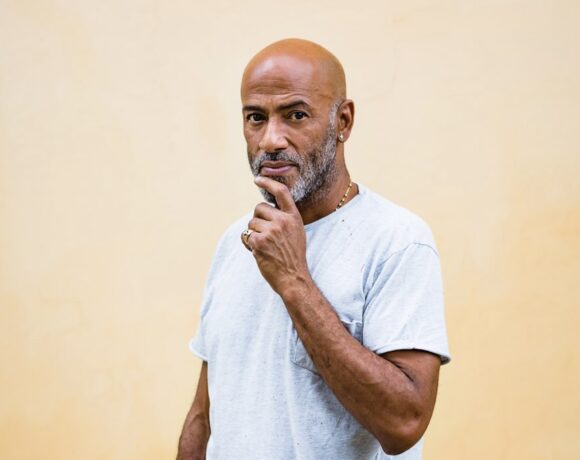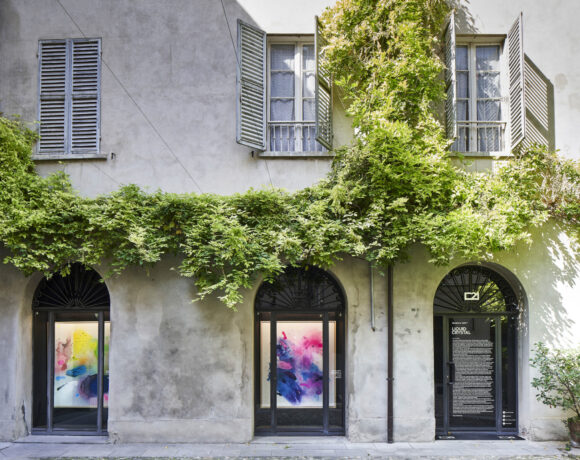Portanova 12, leading gallery in the diffusion of the culture and aesthetics of urban art applied to the small and medium format of collectibles, opens the exhibition season with “Sei cattedrali”, a solo show by Roberto Rizzoli (Bologna, 1952). The exhibition is an original reflection on a project born in 1991 that rethinks the pictorial series created by the artist more than thirty years ago, rereading it with the intent of revealing its intrinsic environmental vocation, highlighting its anticipatory value with respect to what, as the curator Antonio Storelli states, is today «one of the most peculiar and characteristic artistic practices of our contemporaneity». The spaces of the gallery, usually transformed by the bright colors typical of urban muralism, are now marked by six elegant wall canvases, all played on the tones of white, black and gray, which together compose a habitable environment, perfectly calibrated in its symbolic and chromatic power relations. The first inspiration for the cycle stems from the observation of the balance and design rigour of the Modena Cathedral, a monumental medieval architecture that gave Rizzoli the idea of orchestrating his painting as a construction site in which to recreate that unrivalled relationship of correlation and interdependence between detail and macro-structure that the architect Lanfranco, together with the sculptor Wiligelmo and a large team of bricklayers and stonecutters, implemented in the 11th century.

Roberto Rizzoli, “Sei cattedrali”, 1991-1993, installation view at Portanova 12, courtesy Portanova 12, Bologna
The painter’s elaboration is also played out over long periods of time, initially the planning period in which he dedicates himself to graphic studies of (real or mental) objects and to pieces of pure painting, to be reassembled with an equally meticulous execution in a complex visual machine in which the whole functions as a unicum, but each component manages to stand up individually. The realization lasted about two years and was based on the investigation of the infinite possibilities of morphological variation and texture of a predetermined set of geometric or figurative elements free from a precise referent, of which the different combinatorial and expressive possibilities are verified. The recurring geometric motifs, such as the square, the circle or the rhombus, and the repetition of certain apparently more instinctive elements, such as linear undulations and zigzags, and the insertion of objects, such as shells and stars, make up a secular pantheon of symbols emptied of allegorical value. The artist defines these linguistic constructs of his personal vocabulary as «found poetic things», confirming the fact that his reflection is entirely internal to painting and its procedural logic.

Roberto Rizzoli, from the “Sei cattedrali” series, 1991-1993, courtesy the artist and Portanova 12, Bologna
It is fundamental to him the idea of craftsmanship borrowed from the medieval construction site, together with the openness to the accident, unexpected even in the most careful planning, as a fertile trigger for further development potential. The large canvases on display, each measuring approximately three meters by three, therefore appear at the same time homogeneous and extremely varied, whether one considers them in their entire extension or focuses on the details of which they are the sum. In certain cases the surface is animated by a sort of reticulation, obtained with a patient work of masking during the realization phase, which brings to mind the enlarged grain of a silkscreen and its artificial articulation of the planes through the void exhibited even in the search for the flat image, still enlivened at a close look by the leakage of the texture of the support. In other cases the thickness and body of the acrylic colour become more liquid thanks to the overlapping of light glazes and here the three-dimensionality is evoked by a conceptual game of dark shadows completely independent from the elements they are close to, as if their presence made other pictorial objects perceptible that would otherwise be invisible.

Roberto Rizzoli, from the “Sei cattedrali” series, 1991-1993, courtesy the artist and Portanova 12, Bologna
Open spaces that reveal themselves as closed, interchangeable empty and full spaces, imperfect symmetries that push forms to a continuous mutation: this is Roberto Rizzoli’s «poetry of nothingness», as he himself summarizes the ability of painting to “be in itself”, without the need to deceive with a mimetic, expressive or conceptual finalization. The most experimental aspect of the series exhibited at Portanova 12 is the convincing attempt to test this concept on an environmental scale, imagining the paintings as walls and as ideal bas-reliefs in which three-dimensionality takes on a structural value. In the exhibition, in fact, we find some more overtly sculptural objects, presented as mockups of a hypothetical urban implementation of the project. The spectator’s gaze is invited to pass from one surface to another, noting its substantial continuity regardless of whether it is painting in the strict sense or its object translation preparatory to the possible environmental extension. In this constitutive reciprocity, the artist’s language turns out to be surprisingly coherent both with the medieval “organic” logic from which this cycle originates and with the additive and generative processuality of the digital, whose scope in those years had yet to explode. What instead firmly anchors the paintings to the years of their creation is their aesthetic tone, in my opinion more or less consciously nourished by the energetic expressiveness of Keith Haring (not by chance, a street artist) and by the primitivist stylizations of Mimmo Palladino, author during the gold period of the Transavanguardia movement of grandiose pictorial compositions based on the juxtaposition of elementary symbolic or figurative recurrences and of imposing public works, such as for example Porta di Lampedusa (2008), in which the same painting becomes three-dimensional.
Info:
Roberto Rizzoli. Sei cattedrali
12/09 – 5/10/2024
curated by Antonio Storelli
Portanova 12
Via Portanova 12, Bologna
Graduated in art history at DAMS in Bologna, city where she continued to live and work, she specialized in Siena with Enrico Crispolti. Curious and attentive to the becoming of the contemporary, she believes in the power of art to make life more interesting and she loves to explore its latest trends through dialogue with artists, curators and gallery owners. She considers writing a form of reasoning and analysis that reconstructs the connection between the artist’s creative path and the surrounding context.






NO COMMENT